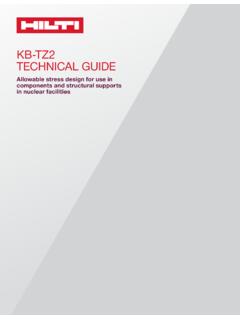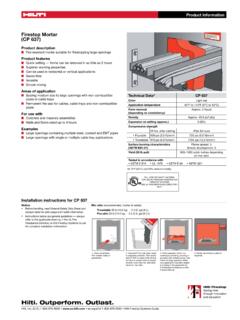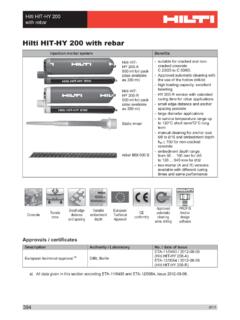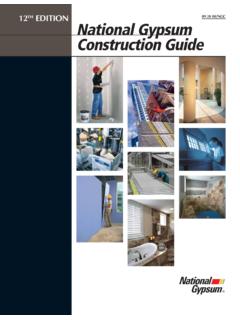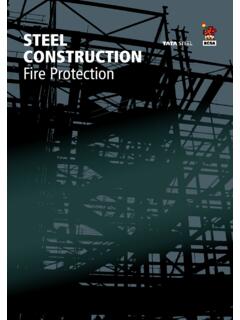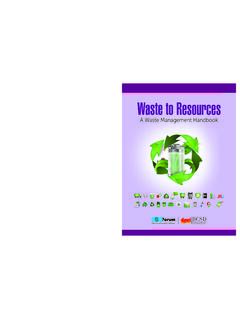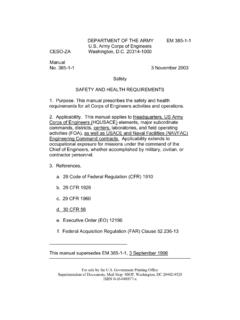Transcription of CORROSION HANDBOOK
1 CORROSION HANDBOOK06/2021206/21 FOREWORDC orrosion is a ubiquitous natural process. Most of us, at some point in our everyday lives, become familiar with the effect that CORROSION has on rusted steel parts. CORROSION has a huge economic impact. About a fifth of the world s annual steel production simply goes towards replacing parts damaged by CORROSION . Even though it may involve higher up-front cost, correct and efficient CORROSION protection at source helps save money and resources in the long run. For fastening systems, it s even more critical because safety is key. Failure due to CORROSION may have dramatic goal of this HANDBOOK is to raise your general awareness of what CORROSION is all about. It provides you with essential information on CORROSION and the behavior of the materials used to protect our products from conducts comprehensive laboratory and field-based tests to assess the CORROSION resistance of its products.
2 Some long-term tests started in the 1980s and are still running today. Thanks to in-house research and close collaboration with renowned universities and laboratories, Hilti is in a position to help offer the right solutions with the most suitable CORROSION protection for a wide variety of environmental , the choice of the material or the CORROSION protection method for a specific application remains the responsibility of the user. Your local Hilti contact will be pleased to provide further assistance. He or she will also be able to obtain support at any time from the specialists in our Corporate Research & Technology department, allowing you to take advantage of the wealth of in-depth know-how we have 1 Basics of CORROSION 4 What is CORROSION ?6 Forms of corrosion6 Uniform CORROSION / shallow pitting corrosion7 Pitting corrosion8 Crevice corrosion9 Environmentally induced cracking11 Intercrystalline (intergranular) corrosion12 Galvanic (contact)
3 Corrosion13 2 Hilti CORROSION performance assessment and product qualification methods13 Purpose of CORROSION testing14 Lab facilities/tests17 Outdoor field tests19 3 Hilti CORROSION protection solutions20 CORROSION and CORROSION protection of carbon steel22 CORROSION behavior of stainless steel26 Prevention of galvanic corrosion28 4 How to assess CORROSION in a specific environment and application28 Factors influencing atmospheric corrosion30 Assessment of corrosivity for zinc and ZM coated products32 Assessment of corrosivity for stainless steel products34 5 How to select a suitable fastener and installation system37 Selecting the right CORROSION protection for anchors, power-driven fasteners and screws38 Selecting the right installation system39 6 Bibliography40 7 Disclaimer406/211 BASICS OF CORROSION What is CORROSION ?
4 CORROSION is the physicochemical interaction between a metal and its environment, which results in changes in the metal s properties and may lead to significant functional impairment of the metal, the environment, or the technical system of which they form a part (see ISO 8044:2010).We only talk about CORROSION when there is a change in the metal s or system s properties that may lead to an undesirable outcome. This can range from simple cosmetic damage to complete failure of technical systems potentially causing great economic damage and even present a hazard to commonly used metals in construction and engineering like steel , aluminum and zinc have a tendency to return to its original state as found in nature. For this reason, CORROSION can be regarded as metal-winning in reverse. Fig. 1 shows how this looks like when iron is extracted from iron winning requires energyFe2O32 Fe + O2unrefined, natural state(stable) CORROSION reactionrefined, metallic state(unstable)Fig 1: Chemical reactions of iron during CORROSION and the metal-winning of CORROSION reactionsBy far the most common type of the CORROSION reaction is electrochemical in nature.
5 Such reactions imply a transfer of electrons from the metal via an environment that can conduct ions, such as a water film on its rarer cases CORROSION reactions can also be purely chemical, as the reaction of a metal surface with hot gases or liquid overall electrochemical CORROSION reaction can be separated into two partial reactions: Metal dissolution, also known as oxidation or anodic reaction Fe Fe2+ + 2 e- Reduction or cathodic reaction In neutral environment and with a sufficient supply of oxygen the cathodic reaction is as follows: O2 + 2 H2O + 4 e- 4 OH-This is the most important cathodic reaction we must consider when corroding our parts in common environmental conditions (also called atmospheric CORROSION ).In acidic environment and with the lack of oxygen following reaction may occur:2H+ + 2e- H2 Even if this reaction, as a partial reaction of CORROSION , occurs much less frequently in atmospheric environments compared to the oxygen reduction, it must nevertheless be taken into account, since the formation of hydrogen here can lead to embrittlement of the metals concerned (see chapter on forms of CORROSION ).
6 06/215 These two partial reactions can take place on the metal surface in a fairly even distribution leading to uniform attack (see section ). Alternatively, they can occur locally and separately, leading to localized forms of CORROSION such as pitting mechanism and the electrochemical nature of the CORROSION reaction define the necessary requirements for atmospheric CORROSION to take place: a conducting metal an electrolyte (a thin, even invisible moisture film on the surface is already sufficient) oxygen for the cathodic reactionThe illustration in Fig. 2 shows the basic CORROSION mechanism of iron under a drop of water. Both metal dissolution and oxygen reduction reactions take place with slight separation on the surface, while their products (Fe-ions and OH-ions) react in the water drop to form iron oxide (red rust).
7 In general, the same scheme applies to other metals such as zinc or aluminum, but with slightly different chemical reactions in the the simple model of the CORROSION reaction, as seen in Fig. 3, we are able to explain many forms of CORROSION and also to put measures in place to help mitigate it. By mitigating these partial reactions, the overall CORROSION rate is also reduced. (OHFWURO\WH H J ZDWHU 2[\JHQ0 HWDO&RUURVLRQFig. 2: Requirements for an atmos pheric CORROSION 3: CORROSION of iron under a drop of water, showing metal dissolution, oxygen reduction and the formation of H H )H 2 2+2+2 H 606 Forms of corrosion1. 2 .1 Uniform CORROSION / shallow pitting corrosionUniform CORROSION removes a metal s surface almost evenly. The partial reactions (metal dissolution and oxygen reduction) are statistically distributed over the surface, leading to a largely homogenous dissolution of the metal and uniform formation of CORROSION products ( red rust on steel ).]
8 The extent of this form of CORROSION can usually be well estimated on the basis of previous experience. The rate of CORROSION is usually given in micrometers per year ( m/a). Using these average values, it is possible to estimate the life expectancy of a component, and thus to enhance its life expectancy by increasing its thickness. Unprotected carbon steel and zinc-coated steel are materials, which typically show uniform or shallow pitting CORROSION in outdoor reality, truly homogenous CORROSION attack is unlikely to take place. There are always areas, especially on complex metal parts, which will corrode faster than others leading to a more or less rough surface with an irregular covering of CORROSION products (see Fig. 4).0 RUH QREOH/HVV QREOHFig. 4: CORROSION of steel Pitting corrosionPitting CORROSION is a localized form of CORROSION that leads to the creation of small holes or pits in the metal (see Fig.)
9 5). This form of CORROSION is mainly found on passive metals. Passive metals and alloys, such as aluminum, titanium and stainless steel owe their CORROSION resistance to a thin oxide layer of only a few nanometers on their surface. The CORROSION process starts with a local break-down of the passive layer. Local corrosive attack can be initiated on stainless steels, for example, by chloride 6 shows the most significant phases of this CORROSION phenomenon on stainless steel . Pitting CORROSION can be quite problematic. Whereas uniform CORROSION can be seen clearly on the surface, pitting CORROSION often appears only as small pinholes. The amount of material removed below the pinholes is generally unknown as hidden cavities may form, making this type of CORROSION more difficult to detect and predict.
10 Technically, there is no reasonable way to control pitting CORROSION so it must be excluded from the outset via design considerations and use of the right materials, engineering and quality addition, pitting CORROSION can often be the starting point for more severe forms of CORROSION such as stress CORROSION cracking (see section Stress CORROSION cracking (SCC) on page 10).Fig. 5: Example of pitting CORROSION on a stainless steel Local breakdown of passivation due to attack of chloride Start of CORROSION on the active (not passive) part of the Anodic dissolution of iron in the pit, oxygen reduction takes place Stainless steel with passivated 6: Phases of pitting CORROSION on stainless , 2+ 2 )H )H H 2+ 2 2+ 2 )H )H H 2+ 2 &, &, 2+ 2 )H )H H 2+ 2 2+ 2 )H )H H 2+ 2 &, &, 2+ 2 )H )H H 2+ 2 2+ 2 )H )H H 2+ 2 &, &, 2+ 2 )H )H H 2+ 2 2+ 2 )H )H H 2+ 2 &, 806 Crevice corrosionCrevice CORROSION refers to CORROSION occurring in cracks or crevices formed between two surfaces (made from the same metal, different metals or even a metal and a non-metal).
